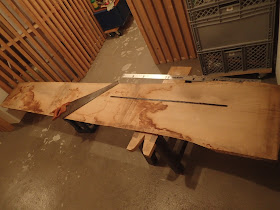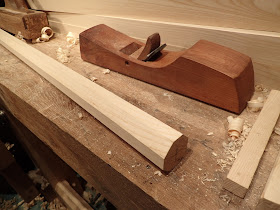Greetings, loyal readers! I'm still here. Instagram is addictive, and tends to suck up a lot of my online creativity. If you aren't there, you are missing out on some real woodworking fun. Several weeks back I started on this project, and have a couple of blog posts in order to catch you up.
I do hate to think I am neglecting my blog, so I feel I need to share bit of what I have been up to in the shop:
Staked Desk ala Welsh Stick Chair inspired by a piece by Christopher Schwarz.
Or, Staked Desk for short.
This project started as an idea I got while gawking at some really wide ash boards at the lumber yard while scoping out wood for another project. I didn't buy them, and when I got home and started thinking about it, I decided that I really should have bought them, so the next day I headed back to the lumber yard.
Since there wasn't an employee pestering me to tell him what I wanted, I took advantage of some time to wander around there by myself to look at all what was available. I found some really nice wide 5/4 oak boards. The Frau wasn't so excited about the idea of an ash desk, so I figured this was the way to go.
 |
| Too big to saw in my Kellerraum shop space, so I used the common space outside of my shop. |
At least I got it home in one piece thanks to my new luggage rack I mounted on the Golf.
 |
| I used to have to saw boards to lengths no longer than 2 meters 30. |
The really great benefit of getting the wood home in one piece is you can really take your time figuring out the best way to cut the wood. I always feel rushed doing it at the lumberyard, and it sucks to regret a crosscut.
The entire design of this desk was done in my preferred way: on the fly with no drawings or cut lists, creating using the dimensions of the rough lumber.
In this case, the board I had was about 18 inches wide, so that is how deep my desk top will be.
 |
| I think this is the widest single board I have ever worked with. |
I picked out a nice section about 40 inches long or so from the middle. It was the nicest looking part of the board. I had no other immediate plans for this wood, so it will go in my scrapwood stash waiting for me to think of something cool to do with it. Perhaps a nice coffee table is in my future, or a couple of oak Shaker side tables with solid slab tops.
The rest of the desk needed to be made out of 8/4 stock (8/4 means two inches thick), and the best, straight grained stuff for staked legs they had was ash. I like ash, and I think it compliments other ring porous woods like oak nicely.
 |
| Ripping legs. |
First up is to rip some pieces that will be appropriate for legs. Having a hand-tool only shop, many would think this part might be a disadvantage, but in this case it is a huge plus, as I can cut them out however I want, ensuring the grain is as straight as possible from the top of the leg to the bottom.
The only thing I should have thought about was it would have been possible to start my tapered legs at this point, saving me having to plane them tapered later. Perhaps next time.
 |
| Since I sawed them square, it was easy to make them all four square. |
I decided I want these legs tapered and octagonal, similar to the legs on the Welsh stick chairs I have built. They will taper from thin at the top to thick at the bottom.
I laid this out with my 48" ruler, and started tapering with my ratty old Swedish jack plane.
 |
| This plane has become a workhorse in my shop. |
I'm not normally one for measuring shaving thicknesses, but I couldn't resist this time. This plane hogs off wood like crazy. It was sweaty work, but it didn't take long with this plane.
 |
| Pretty decent for a thick shaving. |
In no time I had the tapers roughed out.
 |
| All lined up, you can see the tapers on the four legs here. |
Next was to make them octagonal. The jack plane worked well to rough this shape, too, but left some tear out that needed to be dealt with. I haven't used my Krenov jack plane much, so thought I would try it here. The way I made this plane, it takes very fine shavings. It works kind of like a jointing smooth plane.
 |
| Did I invent something? A jointing smoother. |
After the legs were done, I needed the cross-grain battens. These have angles, and look trapezoidal from cross section. You'll see why in a minute, but the idea is that they fit in a sliding dovetail. They need to be thick because not only do they need to keep the panel of the desk top flat, they need to hold the legs.
I chose an angle by eye, and sawed. No idea what the angles are, and I am sure none of them are the same. Those of you OCD engineer types I'm sure are horrified, but really it doesn't matter as long as it looks OK.
 |
| Cross battens angled and sawed to length. |
One of them was perfectly straight grained, and easy to plane. The other one had a bit of a knot where the wood grain turned around. I had the dickens of a time planing it. I was getting tear out like crazy. It was here that I remembered a while back I had rehabbed a #4 sized Sargent smoothing plane. I hadn't used it on anything yet so I figured I give it a go, as nothing else I tried was working.
 |
| Bingo! |
What a relief! The trick with this smoother was with the chipbreaker. I had been setting it far too close to the cutting edge before. Backed off just a gnat's nadger did the trick.
Now that the undercarriage is on track, time to get the desk top sorted.
 |
| Layout tools for a big chunk of lumber. I don't often get to use my layout square. |
I wanted to cut out this piece so it looks square, and was about the right length. First I got to crosscut a bit off of the cracked end,
 |
| New to me crosscut saw. Nice. |
then sawed and jack-planed down to the line I drew out.
 |
| Long boards are a bit of a challenge in my cramped space. |
 |
| For fun I had to play with the microscope mode of my camera. |
Now, the fun part: planing this monster. At least I don't have to deal with any glue lines.
 |
| Even with this plane, this job took a lot of calories. |
At least this oak was relatively well behaved. the grain all goes in the same direction.
I took a bit of a break and decided to taper the ends of the legs in preparation for going into their tapered mortices.
I got to use the drawknife that was given to me by Ray Schwanenberger for the first time. A good, sharp, full size drawknife is a wonderful thing. I look forward to really getting to know this tool. I used it to rough the thick part enough to get the leg into my home-made tapered rounder.
 |
| Now THAT's a knife! |
I made a rounder especially for this desk, as I wanted a taper as big as I could get. The rounders I have are all appropriate for chair parts, but I thought a little more meat on the tenon wouldn't hurt in this case. I made the taper in about two minutes using directions from
Tim Manney's blog.
 |
| This works great. Like a big pencil sharpener. |
Once I reamed out the matching mortice, I was good to go.
 |
| Layout of this joint was greatly assisted by Peter Galbert's book, The Chairmaker's Notebook. |
Back to flattening the desk top.
 |
| The giant problem here was once I got it flat, there was a big stripe going cross grain! |
After some advice by the good folks on Instagram, I took the advice of Chris Schwartz who said to keep going, it will disappear eventually. He was right.
 |
| The dark marks here are just sweat drippings. Yuck! |
Keep an eye out for tomorrow's post. It will include making the sliding dovetail and starting the drawer.





















That is a very nice project. Very inspiring. I am looking forward for part2 of your build report
ReplyDeleteYou shouldn't have to wait long, I plan to have Part II up tomorrow and Part III on Sunday, maybe sooner.
DeleteThanks for the nice comment.
Wow! Thats a wide piece of oak. I've hearrd stories and seen pictures, but have never seen anything that wide in the wild.
ReplyDeleteLooks like a great start to a great project. I'll be looking for tomorrow's post.
It is a joy to work with. The ash was just a bit wider! I feel lucky to have access to such a cool lumberyard.
DeleteLooking like it'll already be a great project.
ReplyDeleteThe MIL said, "Well, it's definitely not too big!"
DeleteIG is great but a good blog post is way better! congrats for this nice build! looking forward to the next parts!
ReplyDeleteI agree. The blessing and the curse if IG is that it is short and instant.
ReplyDeleteHi Brian,
ReplyDeletegreat project and a pragmatic approach.
A seating with similar design principals will be next on my list.
Oh, and that "doing it outside the Kellerraum" is pretty familiar to me.
Cheers,
Stefan
Haha! I knew my fellow German peeps would verstehen.
DeleteI see German and Bavarian chairs build like this all over the place.
Good luck, and send a picture when you're done!